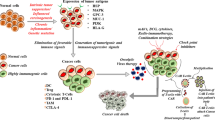Abstract
The immune system is known to play a pivotal role in cancer pathogenesis. In a dynamic balance between immune system and cancer cells, the first one recognizes the second as non-self and effectively clears them from the system. This phenomenon, called immune surveillance, is based on the interaction between antigen presenting cells and T lymphocytes that get activated eliciting a specific and enduring response. In certain circumstances, tumor cells are able to evade this mechanism allowing the tumor to develop. This mechanism is called tumor escape.
The role of immunotherapy is to restore a balance between immune system and tumor cells by boosting the former. In the past, drugs that work on the immune system in various malignancies have shown striking result, in both response rates and survival, which has led to their FDA approval. The use of these new drugs is currently being investigated with promising results in various other settings, including gynecological malignancies.
The definition of immunotherapy encompasses various treatment strategies that include tumor antigen–targeted monoclonal antibodies, immunological checkpoint inhibitors, cytokines, and therapeutic cancer vaccines. These treatments differ as they use distinct mechanisms of actions. However, they all share the fact that their anti-tumor effect is exerted through a boost or a restoration of the immune system.
Owing to its potential to affect mutating cancer cells through the dynamic interplay between cancer and the immune system, immunotherapy offers the potential for durable clinical effects and synergy with subsequent therapies.
Access this chapter
Tax calculation will be finalised at checkout
Purchases are for personal use only
Similar content being viewed by others
References
Candeias SM, Gaipl US (2016) The immune system in cancer prevention, development and therapy. Anticancer Agents Med Chem 16:101–107
Dunn GP et al (2005a) Interferon-gamma and cancer immunoediting. Immunol Res 32:231–245
Dunn GP et al (2005b) A critical function for type I interferons in cancer immunoediting. Nat Immunol 6:722–729
Smyth MJ, Taniguchi M, Street SE (2000) The anti-tumor activity of IL-12: mechanisms of innate immunity that are model and dose dependent. J Immunol 165:2665–2670
Street SE et al (2002) Suppression of lymphoma and epithelial malignancies effected by interferon gamma. J Exp Med 196:129–134
Shankaran V et al (2001) IFNgamma and lymphocytes prevent primary tumour development and shape tumour immunogenicity. Nature 410:1107–1111
Smyth MJ, Dunn GP, Schreiber RD (2006) Cancer immunosurveillance and immunoediting: the roles of immunity in suppressing tumor development and shaping tumor immunogenicity. Adv Immunol 90:1–50
Dunn GP, Koebel CM, Schreiber RD (2006) Interferons, immunity and cancer immunoediting. Nat Rev Immunol 6:836–848
Finn OJ (2008) Cancer immunology. N Engl J Med 358:2704–2715
Dunn GP et al (2002) Cancer immunoediting: from immunosurveillance to tumor escape. Nat Immunol 3:991–998
Schreiber RD, Old LJ, Smyth MJ (2011) Cancer immunoediting: integrating immunity’s roles in cancer suppression and promotion. Science 331:1565–1570
Page DB et al (2014) Immune modulation in cancer with antibodies. Annu Rev Med 65:185–202
Zitvogel L, Tesniere A, Kroemer G (2006) Cancer despite immunosurveillance: immunoselection and immunosubversion. Nat Rev Immunol 6:715–727
Dunn GP, Old LJ, Schreiber RD (2004) The three Es of cancer immunoediting. Annu Rev Immunol 22:329–360
Gravitz L (2013) Cancer immunotherapy. Nature 504:S1
Lizee G et al (2013) Harnessing the power of the immune system to target cancer. Annu Rev Med 64:71–90
De Felice F et al (2015) Immunotherapy of ovarian cancer: the role of checkpoint inhibitors. J Immunol Res 191832
De Vries J, Figdor C (2016) Immunotherapy: cancer vaccine triggers antiviral-type defences. Nature 534:329–331
Kepp O, Senovilla L, Vitale I, Vacchelli E, Adjemian S, Agostinis P, Apetoh L, Aranda F, Barnaba V et al (2014) Consensus guidelines for the detection of immunogenic cell death. Oncoimmunology 3
Palombo F, Focaccetti C, Barnaba V (2014) Therapeutic implications of immunogenic cell death in human cancer. Front Immunol 4:503
Gross S, Lennerz V, Gallerani E, Mach N, Böhm S, Hess D, von Boehmer L, Knuth A, Ochsenbein A, Gnad-Vogt U, Forssmann U, Woelfel T, Kaempgen E (2016) Short peptide vaccine induces CD4+ T helper cells in patients with different solid cancers cancer. Immunol Res 4:18–25
Pardoll DM (2012) The blockade of immune checkpoints in cancer immunotherapy. Nat Rev Cancer 12:252–264
Torre LA et al (2015) Global cancer statistics 2012. CA Cancer J Clin 65:87–108
Bellati F, Napoletano C, Ruscito I, Visconti V, Antonilli M, Gasparri ML, Zizzari IG, Rahimi H, Palaia I, Rughetti A, Benedetti Panici P, Nuti M (2013) Past, present and future strategies of immunotherapy in gynecological malignancies. Curr Mol Med 13:1–22
Galanis E et al (2010) Phase I trial of intraperitoneal administration of an oncolytic measles virus strain engineered to express carcinoembryonic antigen for recurrent ovarian cancer. Cancer Res 70:875–882
Coosemans A et al (2013) Dendritic cell-based immunotherapy in ovarian cancer. Oncoimmunology. 2:e27059
Brahmer J et al (2015) Nivolumab versus docetaxel in advanced squamous-cell non–small-cell lung cancer. N Engl J Med 373:123–135
Hodi FS et al (2010) Improved survival with ipilimumab in patients with metastatic melanoma. N Engl J Med 363:711–723
Zwaveling S et al (2001) Established human papillomavirus type 16-expressing tumors are effectively eradicated following vaccination with long peptide. J Immunol 69:350–358
Welters MJ et al (2008) Induction of tumor-specific CD4+ and CD8+ T-cell immunity in cervical cancer patients by a human papillomavirus type 16 E6 and E7 long peptides vaccine. Clin Cancer Res 14:178–187
Howitt BE et al (2015) Association of polymerase e-mutated and microsatellite-instable endometrial cancers with neoantigen load, number of tumor-infiltrating lymphocytes, and expression of PD-1 and PD-L1. JAMA Oncol 1:1319–1323
Author information
Authors and Affiliations
Corresponding author
Editor information
Editors and Affiliations
Rights and permissions
Copyright information
© 2017 Springer International Publishing AG
About this chapter
Cite this chapter
Gasparri, M.L. et al. (2017). The Immunobiology of Cancer: From Tumor Escape to Cancer Immunoediting Towards Immunotherapy in Gynecologic Oncology. In: Farooqi, A., Ismail, M. (eds) Molecular Oncology: Underlying Mechanisms and Translational Advancements. Springer, Cham. https://doi.org/10.1007/978-3-319-53082-6_9
Download citation
DOI: https://doi.org/10.1007/978-3-319-53082-6_9
Published:
Publisher Name: Springer, Cham
Print ISBN: 978-3-319-53081-9
Online ISBN: 978-3-319-53082-6
eBook Packages: Biomedical and Life SciencesBiomedical and Life Sciences (R0)




